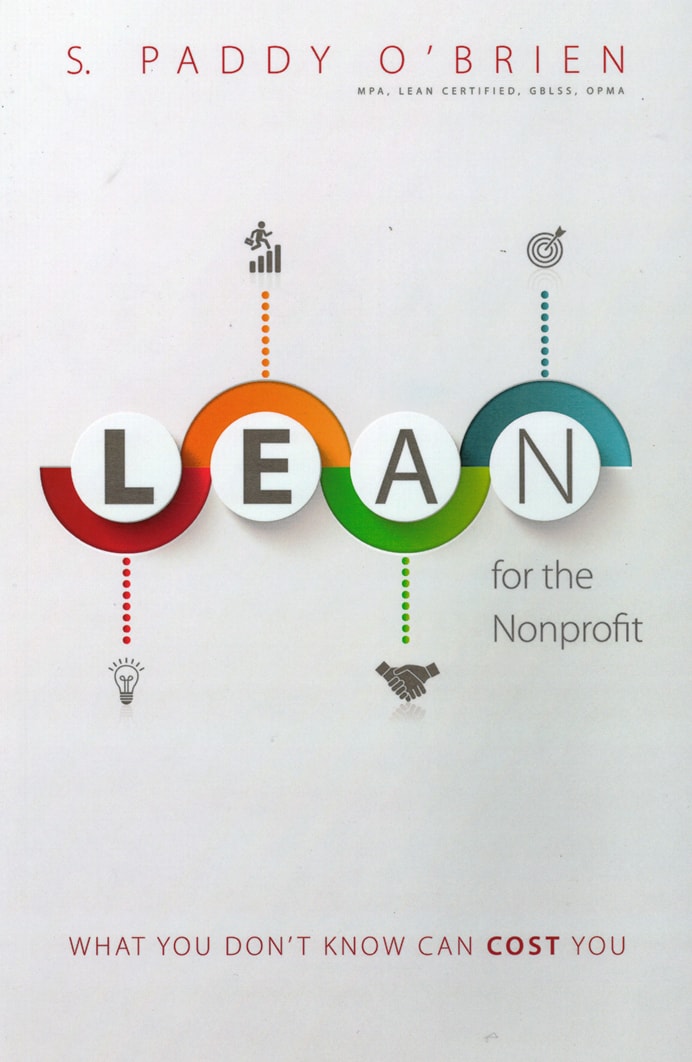LEAN for the Nonprofit. WHAT YOU DON’T KNOW CAN COST YOU
By S.Paddy O’Brien
ISBN: 978-1-62901-411-1
38 pp. Inkwater Press.
Now available in New Zealand! This book can be purchased from Not-for-Profit for $16 including postage in New Zealand. Order by email by clicking on the cover image above.
Payment details will be provided (Credit Card or internet banking).
Sheilah Paddy O’Brien holds a Master’s Degree in Public Administration and a BA; she is certified in Lean, project management and communications. She has written this primer promoting the “Lean” method, “Because donors do not want their money to go to waste, clients want to get the best possible services, and staff and volunteers deserve a different kind of support.”
Lean is a manufacturing method popularised by Toyota and subsequently adopted by a number of organisations including Boeing. It focusses on workflows – called processes in Lean terminology – which are what the customer sees, rather than an organisation’s hierarchical structure. The process is a series of steps flowing sequentially to completion.
In this small book, O’Brien introduces the Lean methodology by way of a case study demonstrating how a zoo managed to improve its customer focus and as a result of the Lean process made cash savings. She goes on to introduce the method using other case studies and diagrams. She notes that ultimately it is the customer that determines whether the processes are working as they should in order to achieve the appropriate outcomes. If there is a problem, workers are brought together in what is known as a Rapid Process Improvement (RPI) workshop with a trained facilitator and a written charter.
Good communication is an essential part of Lean, both between those involved in the RPI workshops and keeping the rest of the staff informed. It requires that those engaged in the Lean team learn the basic goals of the system and O’Brien has produced a flow chart to aid such understanding.
A Lean process uses the minimal resources to achieve the object, anything else is considered to be wasteful. The Lean process seems directly applicable to larger nonprofits – those with a number of staff and/or involved volunteers – though the principals espoused in the book certainly make sense for any organisation. O’Brien does note, however, that “not every workplace problem is a process problem that can be solved by Lean management.” Lean requires the removal of the ‘silo mentality’ and in many ways, this is applicable to even small nonprofit organisations. Likewise, there must be an acceptance that change needs to be brought about.
As noted, this is a primer and as such does not fully detail the Lean process. O’Brien has given a number of examples of the application of the process, sufficient to indicate that the application of Lean principles would benefit a non-profit organisation faced with an appropriate problem. How Lean processes could be applied to smaller bodies – of which there are a large number in New Zealand where only 10% of non-profits employ staff – remains a little unclear. That said, the basic principles outlined in the booklet make good sense.
Reviewed by Larry Robbins
Footnote:
O’Brien lived and worked in Auckland early in her career. At that time she was the Internal Auditor for one of NZ’s largest corporations. Her work assignments took her all over New Zealand and to Sydney and Brisbane.
Now available in New Zealand! This book can be purchased from Not-for-Profit for $16 including postage in New Zealand. Order by email. Payment details will be provided (Credit Card or internet banking). The book is also available through Amazon and other online bookstores.
